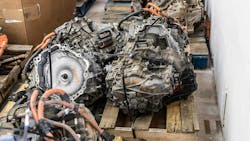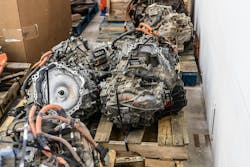Can Advanced Recycling Close the “Rare Earth Gap”?
What you’ll learn:
- China’s recent aggressive posture has introduced new risks into critical-minerals supply chains that impact magnet manufacturers, consumer electronics developers, EV manufacturers, and any business using rare-earth elements or other critical metals in their products.
- Strategic investments in advanced recycling technologies, plus prudent government policies, can turn these threats into opportunities.
- In addition to costing less, and producing fewer pollutants than mining and smelting operations, most recycling processes only incur 15% of the carbon footprint, per one ton of metal, of a conventional process.
Earlier this year, Dr.Ahmad Ghahreman, CEO of the advanced metals recycling company Cyclic Materials (Fig. 1), predicted that that geopolitical tensions over critical battery materials for electric vehicles, consumer technology, and renewable-energy technology will reach an inflection point in 2024. He based this on that fact that 2023 was marked by several remarkable actions on the part of China, including new export restrictions on gallium and germanium products, as well as proposed restrictions on the export of graphite, a critical element required in batteries.
He also said that, despite industry projections of decreased climate tech funding, a combination of improved recovery technologies and shifting geopolitical forces will cause investments in climate technology projects to continue at their present rates, or even increase. He also expects that these investments will favor projects that further the circular economy.
Since our conversation, Ghahreman’s assertions have been repeatedly validated with several new partnerships, the opening of a new rare-earth recovery facility, and several rounds of investments to fund their expansion.
In Electronic Design's interview with Dr. Ghahreman, he explained what led him to make these predictions, and how advanced materials recovery practices will help accelerate the transition to a green economy.
How China’s Actions Are Impacting Critical Minerals Supply Chains
What effect will China's recent actions, and other anticipated restrictions on critical materials and technologies, have on the technology industries, and the economies of other nations?
China’s latest action introduces new risks into critical minerals supply chains—impacting magnet manufacturers, consumer electronics developers, EV manufacturers, and any business that uses rare-earth elements (REEs) or other critical metals in their products. Now more than ever, North American countries understand that we need stable access to critical metals and REEs. As a result, federal governments have introduced bills such as the Inflation Reduction Act to improve critical metals access and fund sourcing, manufacturing, and recycling projects at scale.
The next few years may indeed be challenging as supply works to keep up with rising critical metals demand, especially because most countries rely only on the supply from China. But it won’t be like this forever. As public and private investment in metals supply chains ramps up, access will level out and we will reach an endpoint where the materials necessary to develop innovative technologies of the future are accessible to all.
You also mentioned that the U.S. presently only recycles about 80% of its end-of-life automobiles, compared to 95% of automobiles in the EU, and that North American countries will follow the lead of European countries and adopt a circular mindset with potentially mandatory automotive recycling legislation.
When you say that the U.S. only has a recycling rate of 80%, do you mean that only 80% of the cars are recycled or that the U.S. only recovers 80% of the materials in the waste stream?
The U.S. recycles 80% of the total components in end-of-life (EOL) vehicles, compared to the EU, which recycles 95% of the total components of EOL vehicles. But it’s also true that the U.S. only recycles around 75% to 80% of the total automobiles inside its borders. We must bring both the total components recycled in a vehicle and the total number of vehicles recycled closer to 100% in North America. We can’t keep sending valuable metals to the landfill.
Achieving a 95% Recycling Rate in North America
Why do you feel that it is so important to raise North America's recycling rate? And what are some of the forces that you believe will drive us to do this?
Metals are a finite resource. They don’t grow from the Earth, so there are only two sources: mining new or recycling old. The world has already mined an immense amount of critical metals, yet we’re throwing them away into landfills once we’re finished with the products they make up. It makes no sense.
When mining operations extract metals from the earth, they must disturb an immense amount of land and soil, and the resulting output is ore with very low quantities of the target metal per ton. In what’s considered a successful copper mine today, mining operations extract ores often with just 0.5% copper and 99.5% waste in their mined material. This process also carries an immense carbon and water footprint and leaves behind toxic pollutants that can harm wildlife ecosystems and human health.
In contrast, metals recycling begins with a higher-quality feedstock at the outset. This both increases value and reduces the environmental impact of metal sourcing. At Cyclic Materials, our metals recycling processes carry only 15% of the carbon footprint of traditional mining operations per one tonne of metal we produce. That’s a huge improvement and makes clear that recycling is the best option for the future of the industry (Fig. 2).
Government policy plays the most critical role in accelerating recycling rates in a given country. For example, one of the driving forces for greater recycling of car components in the EU is the policies placed on recycling facilities. North America is more relaxed with these requirements—and that needs to change. The U.S. government filled the Inflation Reduction Act with recycling directives, particularly related to critical metals. I’m optimistic this bill will revolutionize the recycling landscape over the next few years.
What will it take for the U.S. to achieve a 95% recycling rate, and what would the 15% improvement mean in terms of both minimizing the impact of the export bans on critical minerals, and on manufacturers' bottom lines?
It will take reduced supply, federal directives, and increased competition to increase the U.S. recycling rate—all factors the industry currently faces—which is why I’m optimistic we will achieve these targets. And the impact on bottom lines is profound. Manufacturers can access recycled metals for their products at a lower cost of production than sourcing new/virgin metals. And with recycling operations happening right here in North America, manufacturers save on international shipping costs and tariffs.
There’s also the environmental benefit. Using recycled metals reduces the carbon footprint of new product production, which may not save money upfront in manufacturing, but has the potential to make products more market-competitive to consumers. I predict that in the next three to four years, we will see much more competition among OEMs over what percent of their products are made from recycled metals. We are already seeing that competition in select industries today.
Are there other products besides motors that contain sufficient quantities of critical materials to make them economically feasible to process using your technologies?
Absolutely. Manufacturing waste is a big one. Another example is MRI machines, which contain large quantities of recyclable magnets. Because of their massive size, wind-turbine generators also carry good quantities of metals. Hard-disk drives are another source. Even though many modern computers no longer have hard-disk drives, magnets make up the entirety of the cloud.
It’s not just industry-scale products. Many consumer categories contain recyclable magnets—electric bikes and e-scooters, smart-home speakers, and even household appliances like dishwashers, washing machines, and refrigerators. Many products use electric motors because of their efficiency and their ability to operate relatively noise-free.
Why Rare Earth Elements (REEs) Are Irreplaceable in Key Technologies
There’s a lot of work being done to develop technologies that reduce or eliminate our dependence on rare earth and other strategically critical minerals. But will this be enough to solve the problem? Can you share a couple of examples of products and technologies that currently depend on critical minerals which cannot be easily addressed through development of alternative technologies?
The answer to that question is a resounding no. The problem is that REEs are so good at what they do that it's virtually impossible to replace them. Some companies have found niche applications for REE-free magnets. For example, electric golf carts made without REEs work because they don’t require as much power as an all-road vehicle that must have the capability to travel long distances. But this solves such a small market problem that I doubt the hunt for REE alternatives will continue for much longer, if at all.
Products that will likely always depend on critical metals include automobiles, energy solutions such as wind turbines, robots, and others—all booming industries with incredible staying power. Trying to innovate our way out of the critical metals shortage is not an adequate solution, not when recycling these metals is such a viable alternative.
Predictions for Continued Climate-Tech Investment and the Circular Economy
In the predictions you recently issued, you said that despite industry projections that climate tech funding will decrease, a combination of improved recovery technologies and shifting geopolitical forces will cause investments in climate technology projects to continue at their present rates, or even increase. What are some of the key materials and associated applications driving this trend? And how will they contribute to America's economic and political stability?
I expect that climate tech companies will flourish in the near and short term in North America due to increased government support for these ventures. Bills like the IRA are setting a new industry precedent, and there is boundless opportunity for industries to establish themselves and grow in North America.
The other key piece driving this trend is the passion the new generation has for the environment and for solving climate change. The younger generation is rightly concerned about climate change and is committed to building an electric future. I predict that there will be many more entrepreneurs starting innovative businesses to address climate challenges and develop new technologies to reduce industrial carbon footprint.
Combining the will of the government with the spirit of technological innovation and bullish public and private funding means this industry will thrive. Geopolitical challenges are a drive as well.
Can you paint a more detailed picture of the how this will facilitate a shift to a circular economy you expect to see emerge within the North American manufacturing ecosystem over the next 5 to 15 years?
One piece driving the shift to a circular economy is the world’s decarbonization targets. The timelines imposed by governments and companies to reach those targets are only possible if we embrace circularity.
For example, by 2035, Canadians will no longer be able to buy a non-electric vehicle. Meeting that future demand for EVs will only be possible with a steady supply of critical metals. And to secure that supply, the world will need to recycle metals at a rapid rate. In a nutshell, our carbon-neutral future will not happen without the circularity of critical metals.
Would you care to speculate on some of the other opportunities this shift will create for entrepreneurs and investors? That is, what products and technologies should members of the tech community be keeping on their horizons today?
My prediction is that anything and everything that will support an electrified future is worth keeping an eye on. For example, as we make the transition to all-electric vehicles, the world will need more charging stations for those vehicles. Charging stations need software to function, and that software requires maintenance, and so forth. You can make the same analogy for electrified smart-city technologies, such as sensors and robots.
Two other spaces I’m watching are battery technology innovation and electric grid distribution. The next generation of batteries will need to be even more efficient and become even less dependent on high qualities of finite metals. Power grids will need to be expanded and have their efficiency improved by exponential capacities to keep up with power demand in a fossil-fuel-free future. Solutions to help with all aspects of electrification are here to stay and will only grow in the years ahead.
About the Author
Lee Goldberg
Contributing Editor
Lee Goldberg is a self-identified “Recovering Engineer,” Maker/Hacker, Green-Tech Maven, Aviator, Gadfly, and Geek Dad. He spent the first 18 years of his career helping design microprocessors, embedded systems, renewable energy applications, and the occasional interplanetary spacecraft. After trading his ‘scope and soldering iron for a keyboard and a second career as a tech journalist, he’s spent the next two decades at several print and online engineering publications.
Lee’s current focus is power electronics, especially the technologies involved with energy efficiency, energy management, and renewable energy. This dovetails with his coverage of sustainable technologies and various environmental and social issues within the engineering community that he began in 1996. Lee also covers 3D printers, open-source hardware, and other Maker/Hacker technologies.
Lee holds a BSEE in Electrical Engineering from Thomas Edison College, and participated in a colloquium on technology, society, and the environment at Goddard College’s Institute for Social Ecology. His book, “Green Electronics/Green Bottom Line - A Commonsense Guide To Environmentally Responsible Engineering and Management,” was published by Newnes Press.
Lee, his wife Catherine, and his daughter Anwyn currently reside in the outskirts of Princeton N.J., where they masquerade as a typical suburban family.
Lee also writes the regular PowerBites series.





